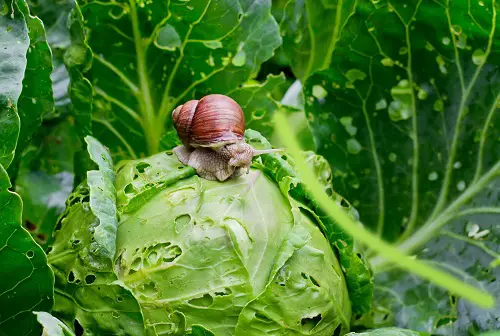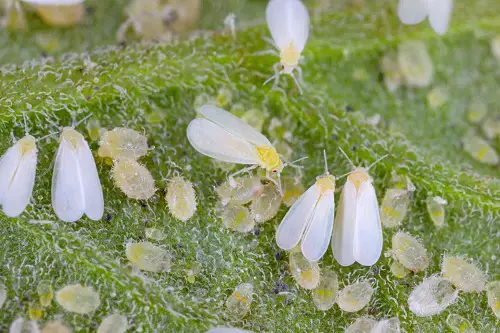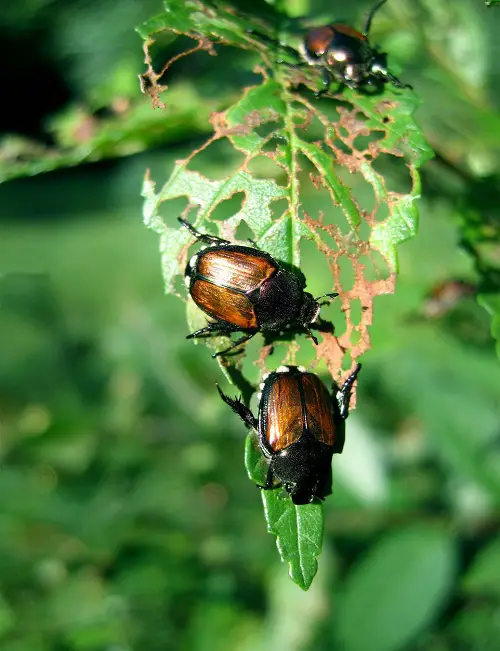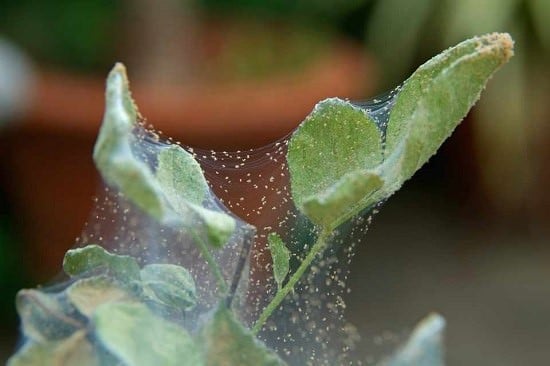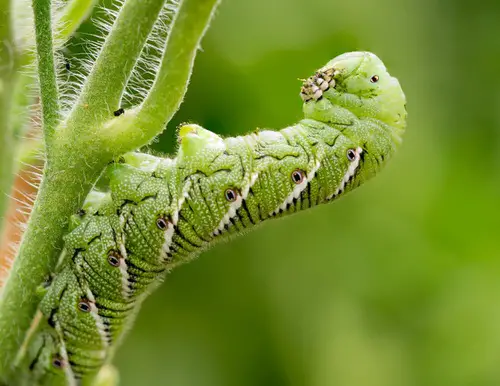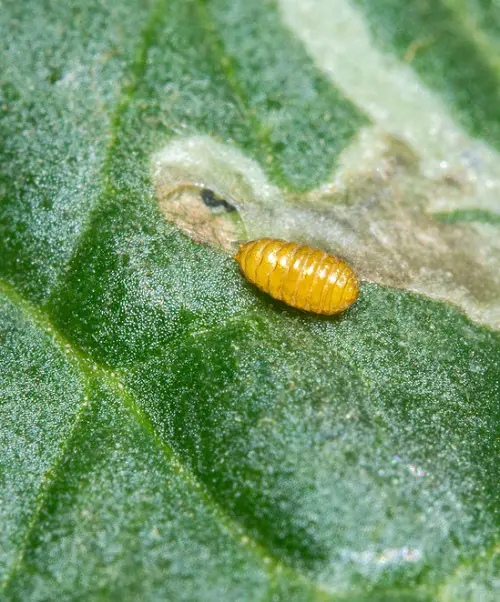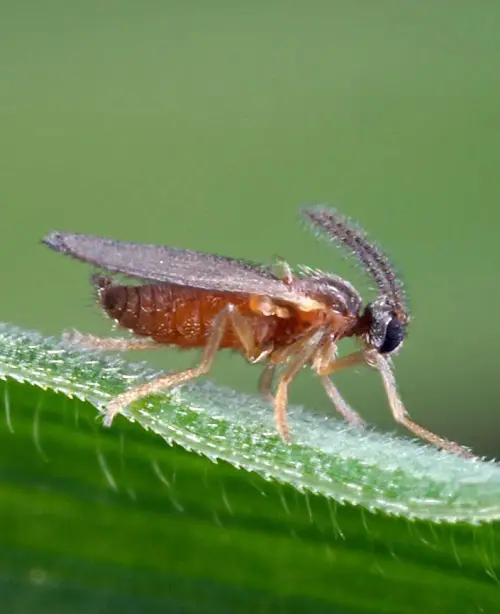Learn about the Types of Common Pests in Your Garden and how to keep your plants safe. From snails to aphids, we’ve got you covered!
A garden is a haven for all things green and growing, but it can also be a hot spot for pests looking for a free meal. Whether you’re growing vegetables or ornamental plants, it’s important to know about the most common pests that can cause damage to your garden. Read on to learn all about the Types of Common Pests in Your Garden!
Learn the Amazing Natural Pesticide Recipe that can Kill any Pest
Types of Common Pests in Your Garden
1. Snails and Slugs
Botanical Name: Pulmonata
These slimy creatures love to munch on young seedlings and leaves, leaving behind tell-tale holes in their wake.
How to Control: Handpick them or use beer traps.
2. Aphids
Botanical Name: Aphidoidea
These tiny insects suck the sap from the leaves of plants, causing them to wilt and turn yellow. They also excrete a sticky substance that attracts ants and can encourage the growth of sooty mold.
How to Control: Wash plants with a strong water spray and encourage native predators such as aphid midges, lacewings, and lady beetles.
3. Mealybugs
Botanical Name: Pseudococcidae
These small, white insects feed on the sap of plants, causing yellowing and stunted growth. They also excrete a sticky substance called honeydew that can attract ants and encourage the growth of sooty mold.
How to Control: Use insecticidal soap or horticultural oil.
Check out our article on getting rid of mealybugs
4. Scales
Botanical Name: Coccoidea
These small, armored insects feed on the sap of plants, causing yellowing and stunted growth. They often look like bumps on the stems or leaves of plants and can be difficult to control.
How to Control: Prune infested parts, encourage native predators, and use dormant or summer oil sprays.
5. Whiteflies
Botanical Name: Aleyrodidae
These tiny white insects feed on the sap of leaves, causing yellowing and stunted growth. They also excrete a sticky substance that can attract ants and encourage the growth of sooty mold.
How to Control: Use yellow sticky cards, insecticidal soap, or horticultural oil.
6. Thrips

Botanical Name: Thysanoptera
These tiny, slender insects feed on the sap of leaves, causing silvery streaks and distorted growth. They can also transmit viruses to plants.
How to Control: Use insecticidal soap or horticultural oil.
Learn How to Make Homemade Insecticidal Soap to Kill Pests
7. Japanese Beetles
Botanical Name: Popillia japonica
These iridescent insects can quickly defoliate a plant, leaving behind only the skeletons of leaves. Keep an eye out for the presence of their tell-tale grubs in the soil.
How to Control: Spray beetles with insecticidal soap
8. Caterpillars
Botanical Name: Lepidoptera
These voracious eaters can quickly defoliate a plant, leaving behind only stems and twigs. Keep an eye out for holes in leaves and the presence of cocoons.
How to Control: Encourage native predators and parasites and handpick.
9. Cabbage Loopers
Botanical Name: Trichoplusia ni
These green caterpillars feed on the leaves of Brassica family plants, causing significant damage to crops like cabbage and broccoli.
How to Control: Use Bt (Bacillus thuringiensis) insecticide.
Read Ways to Use Neem Oil for Houseplants to Kill Pests and Diseases
12. Cutworms
Botanical Name: Noctuidae
These gray or brown caterpillars live in the soil and feed on the stems of young seedlings, cutting them off at ground level.
How to Control: Use cutworm collars on transplants and handpick.
13. Spider Mites
Botanical Name: Tetranychidae
These tiny spider-like pests feed on the sap of leaves, causing yellow speckling and stunted growth. They are especially problematic in hot, dry weather and can reproduce quickly, making infestations hard to control.
How to Control: Use insecticidal soap or horticultural oil.
Know everything about spider mites
14. Ants
Botanical Name: Formicidae
While ants themselves don’t cause direct damage to plants, they can protect and spread pests like aphids and mealybugs in exchange for the sweet, sticky substance (honeydew) that these pests excrete.
How to Control: Use ant baits or insecticidal soap.
15. Earwigs
Botanical Name: Dermaptera
These distinctive insects feed on a variety of garden plants, including flowers, fruits, and vegetables. They can also damage seedlings by chewing on the stems and leaves.
How to Control: Use insecticidal soap or traps.
16. Grasshoppers
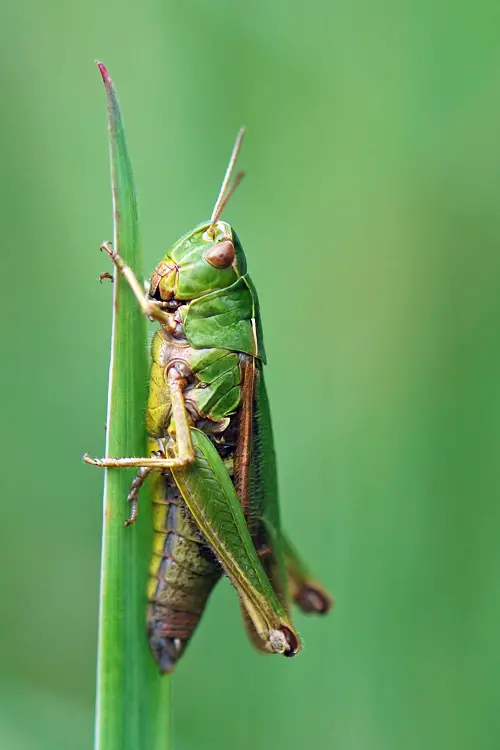
Botanical Name: Acrididae
These large insects feed on a wide variety of plants, including garden vegetables, ornamental plants, and grasses. They can quickly defoliate a plant and reduce yields.
How to Control: Use insecticidal soap or rotating crops.
Learn How to Get Rid of Flies Naturally
18. Squash Bugs
Botanical Name: Anasa tristis
These large, gray-brown insects feed on the sap of plants in the cucumber and squash family, causing yellowing and wilting of leaves. They can also transmit plant diseases.
How to Control: Handpick or use insecticidal soap.
Find out the Benefits of Castile Soap
19. Tomato Hornworms
Botanical Name: Manduca quinquemaculata
These large, green caterpillars can cause significant damage to tomato and potato plants, defoliating entire branches in just a few days.
How to Control: Handpick or use insecticidal soap.
20. Leaf Miners
Botanical Name: Liriomyza spp.
These small flies lay their eggs in the leaves of plants, and the larvae mine between the layers of the leaf, causing significant damage.
How to Control: Prune and dispose of infested leaves to reduce the population of leaf miners. Encourage beneficial insects, such as parasitic wasps, that feed on leaf miners.
Learn the Best Soap Uses in your Home and Garden
21. Cucumber Beetles
Botanical Name: Diabrotica spp.
These small, yellow, and black beetles feed on the leaves, stems, and fruits of cucumber, squash, and melon plants, causing significant damage and reducing yields.
How to Control: You can use Neem oil, a natural insecticide. Spray on the plants to deter beetles.
22. Flea Beetles
Botanical Name: Chrysomelidae
These small, black beetles feed on the leaves of a variety of garden plants, causing small, round holes in the leaves. They can also transmit plant diseases.
How to Control: Repellents, such as botanical oils, can be used to create a barrier that flea beetles won’t cross. Yellow sticky traps can be used to lure and trap flea beetles.
Check out some Clever Vinegar Uses in the Garden
23. Cabbage Maggots
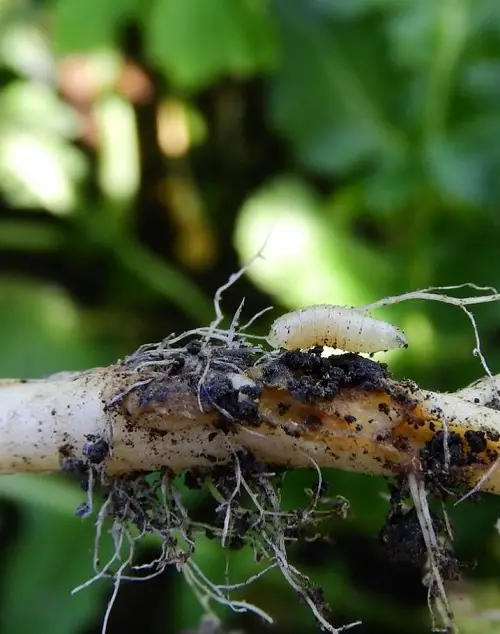
Botanical Name: Delia radicum
Cabbage Maggots are pests that damage crops in the cabbage family, especially Chinese cabbages, and are found throughout North America.
How to Control: Dispose of plant roots by burning them and sprinkling wood ash or red pepper dust around the stems to create a barrier.
Learn about Making Insecticidal Soap at Home
24. Fungus Gnats 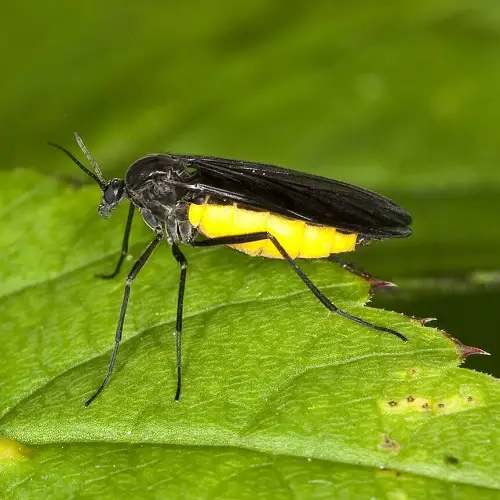
Botanical Name: Sciaridae
Fungus gnats are small, dark-colored insects that are one of the Types of Common Household and greenhouse Pests. They are most commonly found around indoor potted plants and in greenhouses, where they usually feed on decaying organic matter and plant roots.
How to Control: Allow the soil to dry out between watering: Fungus gnats thrive in damp soil. You can also use yellow sticky traps to trap adult gnats in the air. Place them near plants.
25. Leafhoppers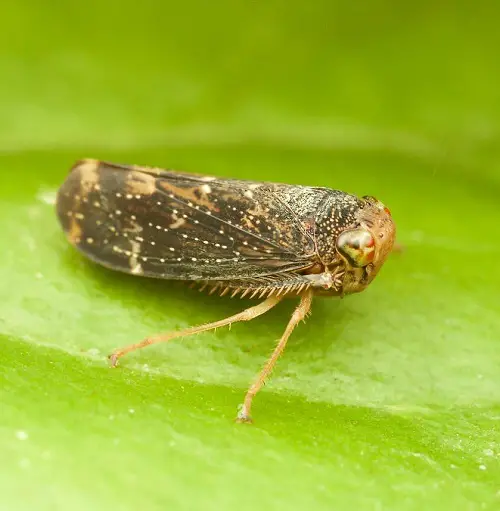
Botanical Name: Cicadellidae
Leafhoppers are tiny, wedge-shaped pests that are typically less than 1.5 inches in size. They feed on the sap of plants, causing curling, yellowing, and wilting of leaves. They can also transmit plant diseases.
How to Control: Use reflective mulch, such as aluminum foil or plastic, to deter leafhoppers. The light reflecting off the mulch confuses the insects, making it difficult for them to locate plants. You can also use insecticidal soap and neem oil as you do on other common pests.
26. Sawfly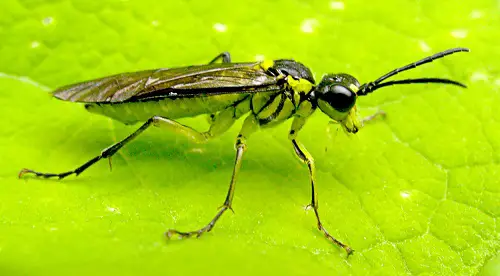
Botanical Name: Symphyta
Sawflies are flying insects that lay their eggs on the underside of leaves. The larvae can cause damage to plants by feeding on the leaves.
How to Control: To get rid of sawflies, prune affected areas and remove the larvae by hand. Applying a natural insecticide can also be effective.
27. Stink Bugs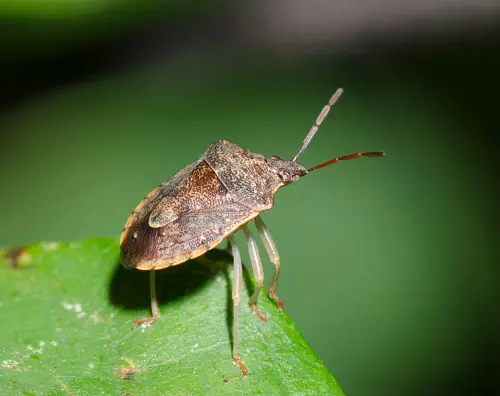
Botanical Name: Pentatomidae
Stink bugs are a common garden pest that can cause damage to many crops. They emit a foul odor when threatened or crushed.
How to Control: Remove any hiding places like weeds or debris to control stink bugs. You can also use row covers, vacuuming, or insecticidal soap to get rid of them.
28. Pillbugs 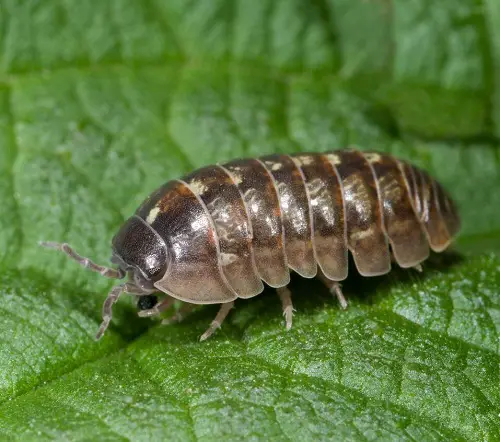
Botanical Name: Armadillidiidae
Pillbugs, known as roly-poly bugs, are small crustaceans that feed on decaying organic matter. They can become a nuisance in gardens when their numbers become too high.
How to Control: Remove piles of decaying organic matter and fix any moisture problems. You can also use a natural insecticide or diatomaceous earth to control their numbers.
29. Vine Weevil 
Botanical Name: Otiorhynchus sulcatus
Vine weevils are small beetles that feed on the leaves and roots of plants. They can be challenging to control because the larvae live in the soil.
How to Control: Apply a natural insecticide to the soil around affected plants. You can also remove the adults by hand or use sticky traps to catch them.
30. Fire Ants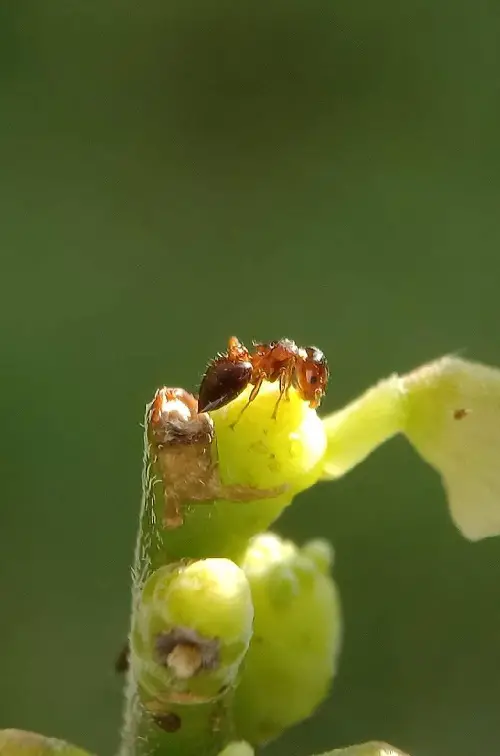
Botanical Name: Solenopsis
Fire ants are aggressive and can give you painful bites. They build mounds in the soil and can damage plants.
How to Control: To control fire ants, apply bait around the perimeter of your garden. You can also use a natural insecticide or boiling water to kill the ants and destroy their nests.
Find How to Make Homemade Insecticidal Soap to Kill Pests
31. Carrot Weevil
Botanical Name: Listronotus oregonensis
Carrot weevils are small beetles that feed on the roots of carrots and related plants. They can cause significant damage to crops.
How to Control: To control carrot weevils, you can rotate crops and remove any affected plants. You can also use row covers to stop the beetles from laying their eggs on the plants.
32. Potato Beetle
Botanical Name: Leptinotarsa decemlineata
Potato beetles are tiny insects that feed on the leaves of potato plants. They can quickly defoliate a plant.
How to Control: You should handpick the adults and larvae from affected plants to control potato beetles. You can also use a natural insecticide or row covers to prevent the beetles from damaging the plants.
33. Hornets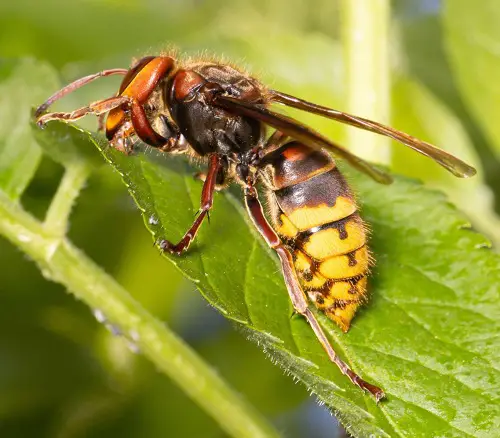
Botanical Name: Vespa
Hornets are large wasps that can be a threat to humans if disturbed. They build nests in trees and other structures.
How to Control: Apply a commercial insecticide to the nest or use a natural alternative like peppermint oil. It is best to seek professional help if you are dealing with a large nest or are trying to find out how to proceed.
34. Wireworms 
Botanical Name: Elateridae
How to Control: Remove any affected plants and rotate crops to control wireworms. You can also use beneficial nematodes or diatomaceous earth to reduce their populations.
35. Aphid Lions
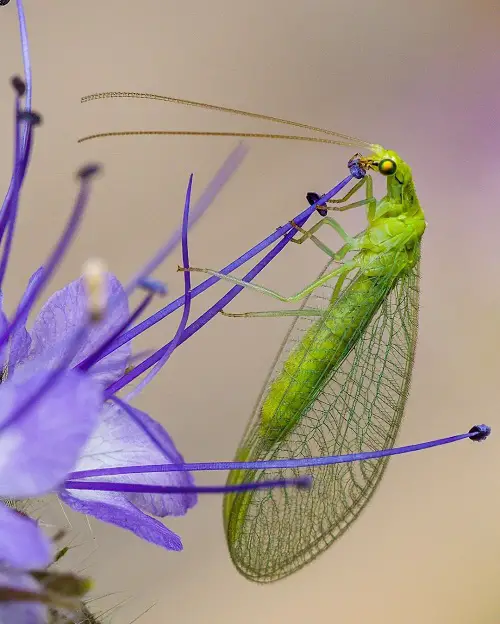
Botanical Name: Chrysoperla spp
Aphid lions are the larvae of green lacewings and are natural predators of aphids and other small insects. They are beneficial insects to have in your garden.
How to Control: Since aphid lions are beneficial insects, avoiding broad-spectrum insecticides is best to discourage their presence in your garden. You can also attract them by planting nectar-rich flowers.
36. Centipedes
Botanical Name: Chilopoda
Centipedes are elongated, carnivorous arthropods that feed on insects, spiders, and other small animals. While they can be frightening, they are generally not harmful to humans but can be damaging to the garden if the population increases.
How to Control: Centipedes are generally not harmful to humans, but they can be controlled by eliminating the insects they feed on. You can also reduce their hiding places by keeping your garden clean and debris-free.
37. Woodlice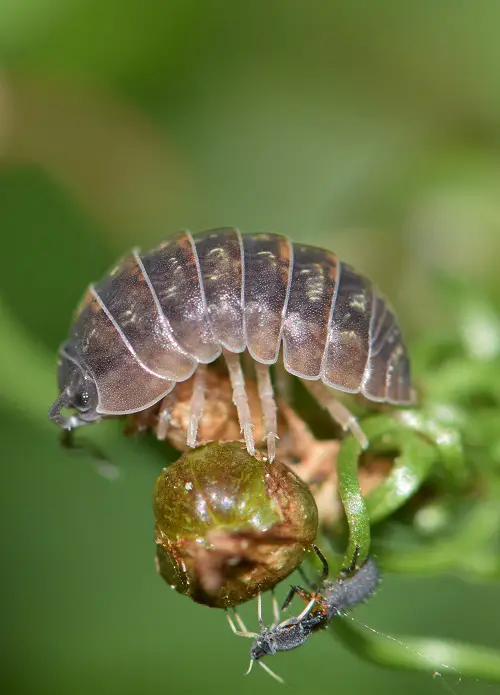
Botanical Name: Oniscidea
Woodlice, also known as pillbugs or roly-polies, are small crustaceans that feed on decaying organic matter. While they are not harmful to plants, they can become a nuisance if their numbers become too high.
How to Control: Woodlice are not harmful to plants but can become a nuisance if their numbers become too high. To control them, remove any decaying organic matter that may attract them and reduce soil moisture.
38. Crane Fly

Botanical Name: Tipulidae
Crane flies are a type of flying insect that resemble giant mosquitoes. While they do not bite or sting, the larvae can cause damage to the roots of plants.
How to Control: You can apply beneficial nematodes to the soil or use insecticides specifically labeled for this pest to control crane fly larvae.
39. Mole Cricket
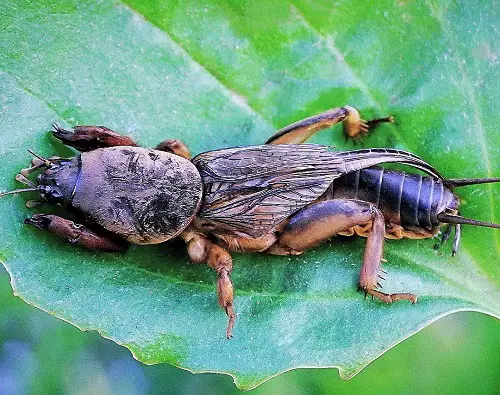
Botanical Name: Gryllotalpidae
Mole crickets are burrowing insects that can cause damage to lawns and gardens by feeding on plant roots.
How to Control: Mole crickets can be controlled by applying pesticides to the soil. You can also encourage the presence of natural predators, such as birds and toads, to help manage their numbers.
40. Squash Vine Borer
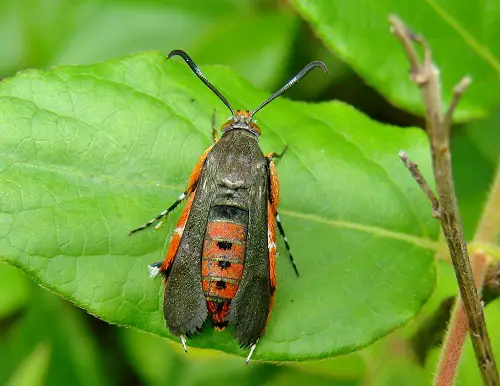
Botanical Name: Melittia cucurbitae
Squash vine borers are the larvae of a kind of moth that feed on the stems and roots of squash plants. They can cause significant damage to crops.
How to Control: To control squash vine borers, you can apply an insecticide to the base of the plants. You can also protect the stems of young plants by wrapping them with aluminum foil or pantyhose.
Check out our article on getting rid of spider mites
41. Tarnished Plant Bug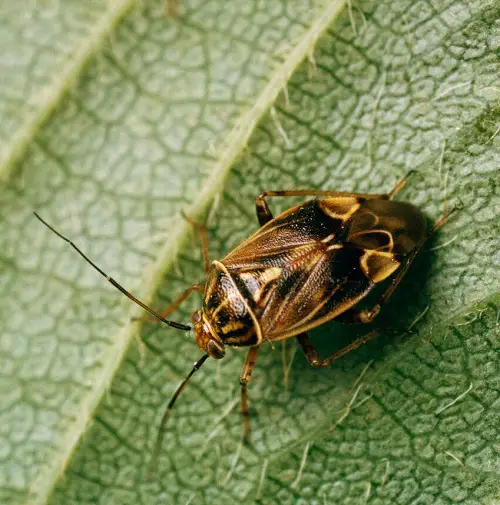
Botanical Name: Lygus lineolaris
Tarnished plant bugs are small, brown insects that feed on the sap of plants. They can cause harm to a variety of crops.
How to Control: Tarnished plant bugs can be controlled by removing weeds or other vegetation harboring them. You can also apply insecticides to the affected plants.
42. Cicadas 
Botanical Name: Cicadoidea
Cicadas are large, noisy insects that emerge from the ground every few years. While they can be a nuisance due to their loud mating calls, they are generally not harmful to plants or humans.
How to Control: Cicadas are generally not harmful to plants or humans but can be controlled by removing any egg-laying sites, such as tree branches, and applying insecticides to the soil.
43. Leafrollers 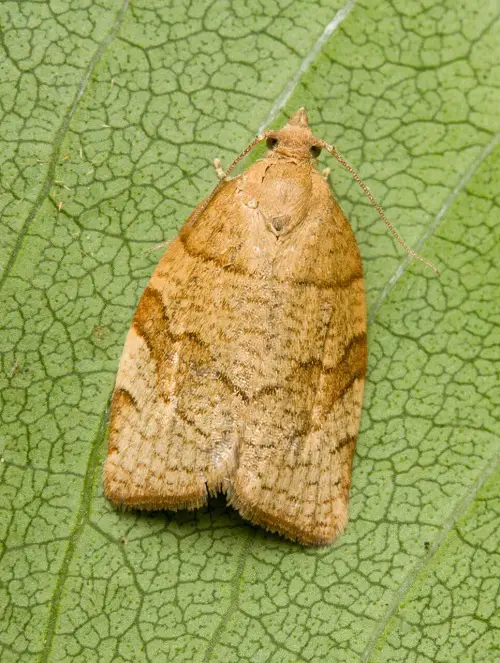
Botanical Name: Tortricidae
Leafrollers are the larvae of a variety of moths and can cause damage to the leaves of plants by rolling them up and feeding them inside.
How to Control: You can prune and destroy any infested leaves or branches to control leafrollers. You can also apply insecticides to the affected plants.
44. Webworms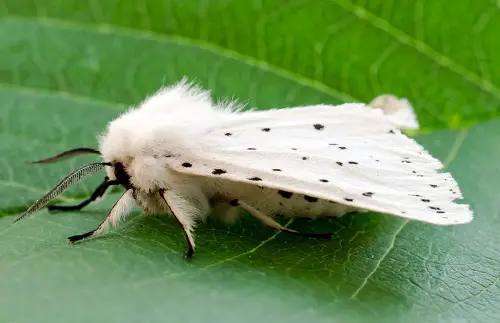
Botanical Name: Hyphantria cunea
Webworms are the larvae of a type of moth that spin webs around the leaves and branches of trees and shrubs. They can cause significant damage to plants.
How to Control: To control webworms, you can prune and destroy any infested branches. You can also apply insecticides to the affected plants.
45. Clover Mites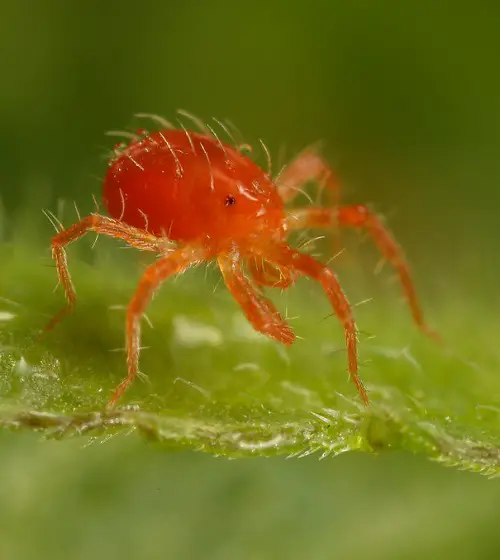
Botanical Name: Bryobia praetiosa
Clover mites are tiny, reddish-brown arachnids that feed on the sap of plants. While they are not harmful to humans, they can become a nuisance in large numbers.
How to Control: Clover mites can be controlled by reducing their hiding places, such as removing grass and weeds around the garden. You can also apply insecticides to the affected plants.
46. Wasps 
Botanical Name: Vespidae
Wasps are flying insects that can be beneficial in controlling other pests. However, some species can also be a threat to humans if disturbed.
How to Control: Since some species of wasps can be beneficial, it’s best to avoid using broad-spectrum insecticides that can harm them. If necessary, you can use targeted insecticides to control specific wasp species.
47. Apple Maggot
Botanical Name: Rhagoletis pomonella
Apple maggots are the larvae of a type of fly that feed on the flesh of apples and other fruit. They can cause significant damage to crops.
How to Control: To control apple maggots, you can use insect traps or insecticides on the affected plants. You can also remove and destroy any infested fruit.
48. Fourlined Plant Bug

Botanical Name: Poecilocapsus lineatus
Fourlined plant bugs are small, bright green insects that feed on the sap of plants. They can cause damage to a variety of crops.
How to Control: To control fourlined plant bugs, you can prune and destroy any infested branches. You can also apply insecticides to the affected plants.
49. Chinch Bugs

Botanical Name: Blissus leucopterus
Chinch bugs are small, black insects that can cause damage to lawns and gardens by feeding on the roots and stems of plants.
How to Control: To control chinch bugs, you can apply insecticides to the affected area. You can also encourage the presence of natural predators, such as birds and ladybugs, to help control their numbers.
50. Gall Midge
Botanical Name: Cecidomyiidae
Gall midges are small flies that lay their eggs in the leaves and stems of plants. The larvae then feed on the plant tissue, causing the formation of galls or swellings on the affected parts.
How to Control: You can prune and destroy any infested branches to control gall midges. You can also apply insecticides to the affected plants. Removing weeds and other vegetation harboring the midges can also help reduce their numbers.


